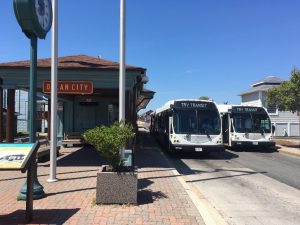
OCEAN CITY – In what amounts to essentially a chicken or egg situation, the resort’s municipal bus service continues to struggle with a driver shortage and associated decline in ridership.
During Wednesday’s Ocean City Transportation Committee meeting, members got an overview of early summer season ridership numbers and a review of where the transit department stands on driver recruitment. While the system continues to meet the demand in general, there are times when the deployments and the need for more drivers are creating challenges.
During the monthly meetings, the committee members review ridership numbers based on the latest available data. Because 2020 and much of 2021 were a wash for the municipal bus system, 2019 is used as a baseline for comparison purposes. Transit Manager Rob Shearman said the numbers for early spring compared favorably to 2019, but there has been a noticeable drop-off since.
“I felt like 2022 ridership was running close to 2019 earlier this year,” he said. “That was true until about mid-May. Now, I think we’re around two-thirds.”
Just like about every other town department, transportation has struggled with recruiting and retaining personnel. As a result, the number of drivers available, and thus the number of deployments, continued to curtail the number of buses available at certain times, according to Shearman.
“Our deployment currently is about 75% of what is was at the same time in 2019,” he said. So far in June, disturbingly, we’re deploying about 50% of where we were in 2019.”
When asked if the recent decline in ridership was related to the lack of available drivers and deployments, Shearman said that is just one part of a larger equation.
“It’s a variety of factors,” he said. “There is still some anxiety about COVID transmission among some riders. I do believe we’re leaving some people on bus stops.”
Shearman said the town’s articulating buses were helping with moving people around during peak times with less drivers and less deployments, but that has not come without its challenges. Two of the town’s eight articulating buses are currently in the shop with various issues, making the number available at six. Public Works Director Hal Adkins said those two articulating buses in the shop could be deployed again soon, and there are more on the way.
“We still have two artics in the grant tunnel,” he said. “That will get us back to eight. That should help address some of the ridership numbers.”
Of course, through the first few weeks of June, the majority of the resort’s municipal bus system ridership is driven by recent graduates, often fraught with problems associated with young adults. Operations Manager George Peake said that has not changed this year, but that there have been few incidents on the buses and few cases of vandalism or destruction of property.
“The graduates are still the bulk of our ridership at this time of June,” he said. “Generally speaking, this is the rough week. We haven’t seen any real issues. So far, so good.”
Peake said the deployment and ridership numbers could go hand in hand. The number of municipal bus drivers currently available is 67. In the base-line year of 2019, there were 120 available. Peake said there were currently five drivers on medical leave, although a few could be returning shortly. Eight school bus drivers are also expected to join the ranks now that the school year is nearing its end.
Peake said with the addition of the school bus drivers and the couple in the Commercial Driver’s License (CDL) process, the town could get to around 75, which could handle the peak demands for the transit system.
Of course, keeping the town’s municipal bus fleet up and running is always challenging. Peake said there is also a dire need for vehicle technicians.
“We have three currently,” he said. We’d really like to have 12. Our plan is to get through the season and re-evaluate. We’re going to do a lot of cross-training in the offseason, where our personnel can drive buses, be vehicle technicians or dispatchers, or whatever else we need at a given time.”
With the shortage of drivers and the associated decline in deployments, a question arose about the service to the Park-and-Ride in West Ocean City. Peake explained there is one 10-hour shift dedicated to making a loop to the Park-and-Ride, which ends at 9 p.m. each day. After that, dispatchers will deploy a bus from its loop in town to meet the demand, if necessary, at the West Ocean City facility. The town’s municipal bus service provides a link for employees that connect to jobs in Ocean City via the Shore Transit system, but Peake said the demand is generally low.
“The Park-and-Ride is not very popular right now,” he said. “There is no real demand to go over there after the last Shore Transit stop.”
Mayor Rick Meehan said while it is important to provide transportation into town utilizing Shore Transit to reach the resort from other areas, he questioned if the transit department’s resources and manpower could be better served in town.
“We need to maximize our resources,” he said. “If the number of riders is two, then maybe we need to reconsider a dedicated loop over there. We need to look at getting as many buses as we can on Coastal Highway during those hours when the downtown area is emptying out.”

